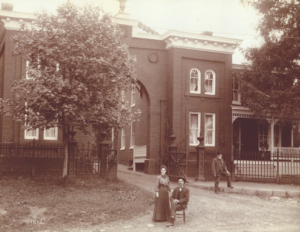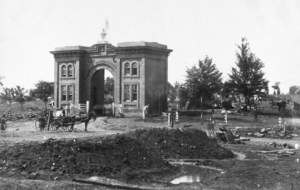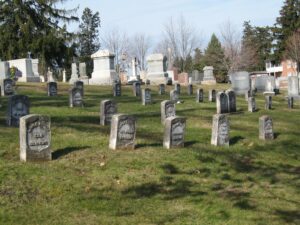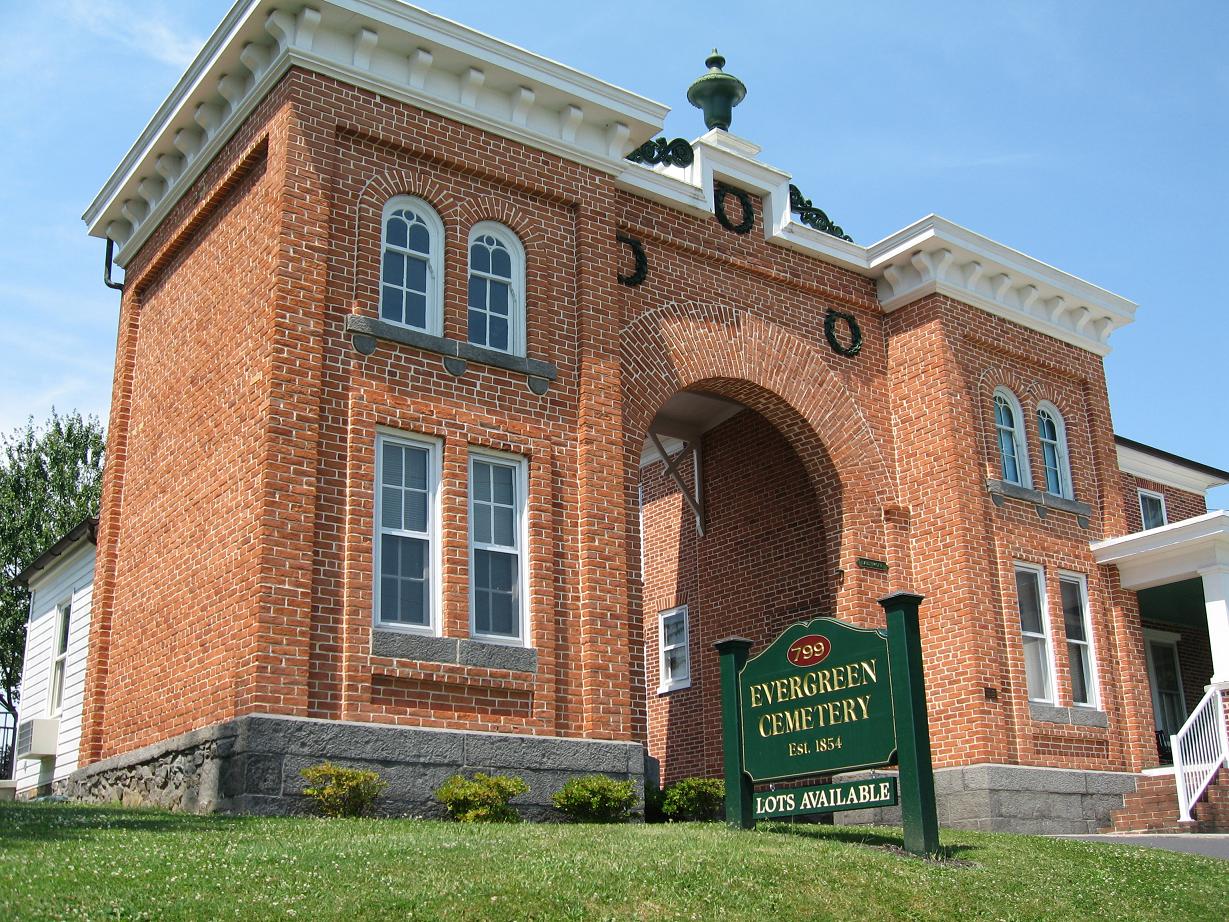
Gettysburg’s Evergreen Cemetery: Keystone of the Battleground
January 26, 2024Imagine standing on hallowed ground, where the echoes of the past linger—a quiet sanctuary of bereavement and rest, centrally placed to witness pivotal moments in our nation’s history. Evergreen Cemetery is not just another burial ground; it’s a living testament to the town and inhabitants of Gettysburg and their sacrifices before, during, and since the Civil War.
Evergreen Cemetery in Gettysburg, Pennsylvania, holds a significant place in American history and was at the very center of the Battle of Gettysburg. The strategic landmarks known as “Cemetery Hill” with its adjoining “Cemetery Ridge” were eponymously designated after Evergreen Cemetery, which topped Cemetery Hill, and throughout the fierce battle, Evergreen Cemetery acted as headquarters and central rallying point for the Union army.
This cemetery is no mere battlefield location or collection of gravestones; it’s a living museum preserving stories of valor, loss, and resilience. To truly experience the deep resonance of this historic patch of sacred ground, today’s visitors embark on a journey through the deep historic significance that permeates this site. There’s more to Evergreen Cemetery than meets the eye.
Founded in 1853
Evergreen Cemetery – formerly called Citizen’s Cemetery and Ever Green Cemetery – is a historic 29.12 acre rural cemetery located just outside Gettysburg Borough in Adams County, Pennsylvania. Today, it is part of the Gettysburg Battlefield Historic District and is surrounded by Gettysburg National Military Park and Soldiers’ National Cemetery.
The Ever Green Cemetery Association of Gettysburg was first established on November 29, 1853. The association managed the property and oversaw its caretakers. The first interment took place on October 29th, with official opening ceremonies shortly thereafter.
The Evergreen Cemetery gatehouse was designed by Philadelphia architect Stephen Decatur Button and built by local contractors George and Henry Chritzman in 1855. The original gatehouse, which still stands today, also formally served as the official caretaker residence.
The Cemetery of Cemetery Ridge
Evergreen Cemetery stands atop Cemetery Hill, an area that became the central hub of the Union position throughout the Battle of Gettysburg. The high ground of the cemetery itself was lined with cannons and used as a natural artillery platform during the conflict, while the gatehouse was occupied by Union troops and became the battle headquarters of the XI Corps (Union Army).
At sunset on July 2, 1863, the Battle of East Cemetery Hill was fought when Confederate troops charged the hill’s artillery batteries. Federal soldiers took up firing positions amidst the cemetery tombstones, laying many of them on the ground and sheltering behind them to evade enemy fire. A counter-attack by soldiers hidden within the cemetery merged with additional Union forces to successfully drive the attackers back and prevent the cemetery from being taken.
Evergreen Cemetery experienced three days as an army camp and battlefield, after which its paths were trodden down, its fences were flattened, and many of its iron-fenced burial plots and larger monuments were damaged and destroyed.
When the battle ended, many fallen soldiers were hastily buried there, where they would remain until they could be exhumed and transplanted into the new Soldiers National Cemetery built nearby in the months after the battle.
Some 69 Union battle casualties were not exhumed and remained in Evergreen Cemetery permanently, along with two fallen Confederates who were also permanently interred there, though the two Confederates would eventually be transferred to unmarked graves to deter vandalism.
The Gettysburg Address
The cemetery had another important role to play in our nation’s history after the great battle ended. Four months after the battle, at the dedication of the new immediately-adjacent National Cemetery, President Abraham Lincoln delivered his famous “Gettysburg Address” from atop a platform within Evergreen Cemetery.
The precise location where Lincoln delivered his famed address was lost to history for over a century and a half. Recently, however, using photographic evidence of the period and by means of a computer simulation and virtual triangulation, historians have been able to closely identify the exact location where Lincoln likely stood. It’s not where the Soldiers’ National Monument stands, and it isn’t formally marked today, but visitors can now stand on the actual site where Lincoln’s platform formerly stood when he gave the famous speech. That location straddles the fence line of today’s boundary between Evergreen Cemetery and the National Cemetery, near the grave of Gettysburg’s sole civilian casualty, Jennie Wade.
The Murder Fence
The hand of fate had already brushed the Evergreen Cemetery even before the fateful three-day battle in July 1863 cemented Gettysburg in the firmament of our collective history forever. Evergreen Cemetery shares an iron fence with the Soldiers National Cemetery, consecrated by Lincoln five months after the battle, in November 1863.
But that Iron Fence had a history all its own. Four years earlier, in 1859, in Washington, D.C, Philip Barton Key II, son of the same Francis Scott Key who penned what would become the American National Anthem, “The Star-Spangled Banner,” was unceremoniously shot to death in Lafayette Square. Legend has it that as Key succumbed to his mortal wound, he collapsed and fell against a certain wrought iron fence that encircled the park at that time.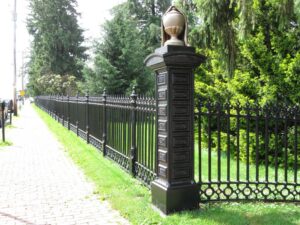 Key was shot by Daniel Sickles, who suspected Key of having inappropriate relations with Sickle’s wife and who gunned down his rival, having allegedly entered into a psychotic state, in what would later be called “an act of passion.”
Key was shot by Daniel Sickles, who suspected Key of having inappropriate relations with Sickle’s wife and who gunned down his rival, having allegedly entered into a psychotic state, in what would later be called “an act of passion.”
Sickles was acquitted on the murder charges, having successfully invoked a defense based on his supposed “temporary insanity.” It’s worth noting that the Sickles case was the first successful use of the defense in American legal history.
Daniel Sickles, acquitted of murder, would go on to become a General in the Union Army who would serve under General George Meade’s command at the Battle of Gettysburg.
Meanwhile, the wrought iron fence against which Key collapsed would later be removed from Washington and transported to Gettysburg to be installed around the newly consecrated Soldiers National Cemetery, which today shares a boundary with Evergreen Cemetery.
Both the acquitted murderer and the fence against which his victim died would come to Gettysburg… but only the iron fence would stay. You can still see it today, encircling Soldiers Cemetery and adjoining Evergreen Cemetery.
Beyond the Battlefield: How Did Evergreen Cemetery Evolve Over Time?
Evergreen Cemetery isn’t frozen in the past—it’s a living testament to the evolving nature of history. From the initial burials before and during the Civil War to the expansion of grounds in subsequent decades, each chapter of growth has reflected the changing landscape of Gettysburg and the nation’s evolving attitude towards remembrance. Years of modest development and thoughtful care have rendered Evergreen Cemetery the poignant landmark it is today, a treasure for future generations to visit and enjoy.
Now that you’ve learned about the captivating history of Evergreen Cemetery, I urge you to take a stroll through its hallowed grounds yourself. Visiting this sacred site offers a tangible connection to the past and allows you to pay your respects to those who shaped the course of history. So, lace up your walking shoes, make your way to this memorable destination, and let the stories etched in stone speak to you. Whether you’re a history buff, a nature enthusiast, or someone seeking a moment of reflection, Evergreen Cemetery beckons. Go ahead, step into the footsteps of the past, and let the whispers of history guide your steps.
Visit Gettysburg in Person
Plan your next excursion with us! Our bus tours of the historic Gettysburg Battlefield are ready to show you the sites of the historical battleground. Reservations can be made by calling our toll-free number at 877-680-8687. You can also purchase bus tour tickets online. Tours depart from the Gettysburg Tour Center located at 777 Baltimore St., Suite 100.
